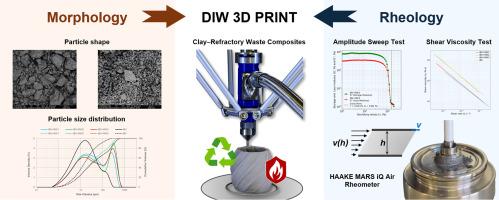陶瓷结构直接油墨书写用粘土-耐火废料复合材料的流变学表征
IF 2.8
Q1 MATERIALS SCIENCE, CERAMICS
引用次数: 0
摘要
在循环经济和原材料可持续性的背景下,探索具有优化物理和机械性能的配方的替代原材料至关重要。本研究的重点是耐火陶瓷废料与粘土混合的流变特性,旨在优化3D打印的成分。确定了一种具有最高强度和抗剪切应力的混合物,使其成为复杂结构部件中有希望使用的候选者。较低强度的混合物被证明适用于要求较低、几何形状较简单的应用。更细的颗粒和更低的堆积密度导致填料粘度和临界剪切应力的增加,有助于提高机械稳定性。相比之下,体积密度较高的混合物表现出较低的粘度和较低的机械载荷阻力,尽管在线性粘弹性区域内表现出较高的弹性。这些发现对增材制造耐火陶瓷配方的有效选择和设计做出了重大贡献,可以根据目标应用的特定功能要求进行定制。该研究还证明了使用废物衍生材料作为耐火陶瓷直接墨水书写(DIW) 3D打印原料的可行性,支持材料循环和可持续制造实践。本文章由计算机程序翻译,如有差异,请以英文原文为准。

Rheological characterization of clay–refractory waste composites for direct ink writing of ceramic structures
In the context of the circular economy and raw material sustainability, it is essential to explore alternative raw materials for the development of formulations with optimized physical and mechanical properties. This study focused on the rheological characterization of refractory ceramic waste blended with clay, aiming to optimize compositions for 3D printing. A mixture exhibiting the highest strength and resistance to shear stress was identified, making it a promising candidate for use in complex structural components. Mixtures with lower strength proved suitable for less demanding applications with simpler geometries. The presence of finer particles and lower bulk density of the filler led to increased viscosity and critical shear stress, contributing to higher mechanical stability. In contrast, mixtures with higher bulk density exhibited lower viscosity and reduced resistance to mechanical loading, despite demonstrating higher elasticity within the linear viscoelastic region. These findings represent a significant contribution to the effective selection and design of refractory ceramic formulations for additive manufacturing, tailored to the specific functional requirements of targeted applications. The research also demonstrated the feasibility of using waste-derived materials as feedstock for Direct Ink Writing (DIW) 3D printing of refractory ceramics, supporting both material circularity and sustainable manufacturing practices.
求助全文
通过发布文献求助,成功后即可免费获取论文全文。
去求助
来源期刊

Open Ceramics
Materials Science-Materials Chemistry
CiteScore
4.20
自引率
0.00%
发文量
102
审稿时长
67 days
 求助内容:
求助内容: 应助结果提醒方式:
应助结果提醒方式:


